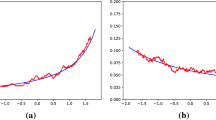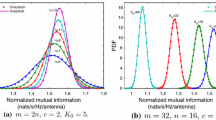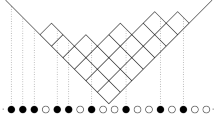Abstract
We characterize the limiting smallest eigenvalue distributions (or hard edge laws) for sample covariance type matrices drawn from a spiked population. In the case of a single spike, the results are valid in the context of the general \(\beta \) ensembles. For multiple spikes, the necessary construction restricts matters to real, complex or quaternion (\(\beta =1,2,\) or 4) ensembles. The limit laws are described in terms of random integral operators, and partial differential equations satisfied by the corresponding distribution functions are derived as corollaries. We also show that, under a natural limit, all spiked hard edge laws derived here degenerate to the critically spiked soft edge laws (or deformed Tracy–Widom laws). The latter were first described at \(\beta =2\) by Baik, Ben Arous, and Peché (Ann Probab 33:1643–1697, 2005), and from a unified \(\beta \) random operator point of view by Bloemendal and Virág (Probab Theory Relat Fields 156:795–825, 2013; Ann Probab arXiv:1109.3704, 2011).
Similar content being viewed by others
Notes
In [19] the generator is denoted by \(-{\mathfrak {G}}\), with \({\mathfrak {G}}^{-1}\) reserved for the Green’s operator. This should’t cause confusion here.
In [19] we also flipped the indexing by conjugating as in \(B \mapsto S B S^{-1}\) with \(S_{ij} = (-1)^i \delta _{i+j - n-1}\). With the benefit of hindsight it is more convenient not to make this extra move.
Throughout we use the convention that exponents of the form \(b \mapsto b^{\alpha {+}}\) or \(b^{\alpha -}\) indicate that the appraisal in question holds for \(\alpha \pm \epsilon \) with any choice of \(\epsilon > 0\). In the present example, [19] reports an exponent of 3 / 4 in the bounding function \(\phi \), but the proof there shows that this can be replaced by anything greater than 1 / 2.
Throughout \([\cdot ]\) denotes the (appropriate) integer part.
This computation is more or less reproduced in [22]. It should be clear afterwards how everything goes through in the quaternion case (in the real case there are no subtleties—the \(\hbox {diag}(Q_x)\) term is not present and the Brownian motion \(B_x\) is isotropic).
Here we are tacitly assuming that the limiting starting point w is finite, if \(a^{-2/3}c - a^{1/3} \rightarrow \infty \) an additional approximation step is needed, but this has been carried out in [19].
References
Baik, J., Ben Arous, G., Péché, S.: Phase transition of the largest eigenvalue for non-null complex sample covariance matrices. Ann. Probab. 33, 1643–1697 (2005)
Bauer, G., Kratz, W.: A general oscillation theorem for selfadjoint differential systems with applications to Sturm-Liouville eigenvale problems and quadratic functionals. Rend. Circ. Mat. Palermo (2) 38, 329–370 (1989)
Bloemendal, A., Virág, B.: Limits of spiked random matrices I. Probab. Theory Relat. Fields 156, 795–825 (2013)
Bloemendal, A., Virág, B.: Limits of spiked random matrices II. Ann. Probab. (2011, To appear). arXiv:1109.3704
Borodin, A., Forrester, P.J.: Increasing subsequences and the hard-to-soft transition in matrix ensembles. J. Phys. A Math. Gen. 36, 2963–2982 (2003)
Cépa, E., Lépingle, D.: Diffusing particles with electrostatic repulsion. Prob. Theory Relat. Fields 107, 429–449 (1997)
Cépa, E., Lépingle, D.: Brownian particles with electrostatic repulsion on the circle: Dyson’s model for unitary random matrices revisted. Esaim Prob. Stat. 5, 203–224 (2001)
De La Peña, V., Klass, M.J., Lai, T.-L.: Self-normalized processes: exponential inequalities, moment bounds and iterated logarithm laws. Ann. Probab. 32, 1902–1933 (2004)
Desrosiers, P., Forrester, P.: Asymptotic correlations for Gaussian and Wishart matrices with external source. Int. Math. Res. Not. 2006, 43, Art. ID 27395 (2006)
Dufresne, D.: The distribution of a perpetuity, with application to risk theory and pension funding. Scand. Actuar. J. 1990, pp. 39–79 (1990)
Dumitriu, I., Edelman, A.: Matrix models for beta ensembles. J. Math. Phys. 43, 5830–5847 (2002)
Edelman, A., Sutton, B.: From random matrices to stochastic operators. J. Stat. Phys. 127, 1121–1165 (2007)
Forrester, P.J.: Probability densities and distributions for spiked Wishart \(\beta \)-ensembles. Random Matrices Theory Appl. 2, 1350011 (2013)
Itô, K., McKean, H.P.: Diffusion processes and their sample paths. Springer-Verlag, Berlin-Heidelberg-New York (1974)
Ledoux, M.: The concentration of measure phenomenon. In: Math. Surveys Monographs, vol. 89. AMS (2001)
Mo, M.Y.: The rank 1 real spiked model. Commun. Pure Appl. Math. 65, 1528–1638 (2011)
Newman, C.: The distribution of Lyapunov exponents: exact results for random matrices. Commun. Math. Phys. 103, 121–126 (1986)
Norris, J.R., Rogers, L.C.G., Williams, D.: Brownian motions of ellipsoids. Trans. Am. Math. Soc. 294, 757–765 (1986)
Ramírez, J., Rider, B.: Diffusion at the random matrix hard edge. Commun. Math. Phys. 288, 887–906 (Erratum CMP 307, 561–563 (2011)) (2009)
Ramírez, J., Rider, B., Virág, B.: Beta ensembles, stochastic Airy spectrum, and a diffusion. J. Am. Math. Soc. 24, 919–944 (2011)
Ramírez, J., Rider, B., Zeitouni, O.: Hard edge tail asymptotics. Electron. Commun. Probab. 16, 741–752 (2011)
Rider, B., Valkó, B.: Matrix Dufresne identities. IMRN, vol. 2015 (2015). doi:10.93/imrn/rnv127
Rumanov, I.: Hard edge for \(\beta \)-ensembles and Painlevé III. Int. Math. Res. Not. 2014, 6576–6617 (2014)
Rumanov, I.: Painlevé representation of \(\text{ Tracy-Widom }_{\beta }\) for \(\beta =6\). Commun. Math. Phys. 342, 843–868 (2014)
Simon, B.: Trace ideals and their applications (second edition). In: Math. Surveys and Monographs, vol. 120. AMS (2005)
Stroock, D.W., Varadhan, S.R.S.: Multidimensional Diffusion Processes. Springer-Verlag, Berlin-New York (1997)
Sutton, B.: The stochastic operator approach to random matrix theory, PhD thesis, Massachusetts Institute of Technology (2005)
Tracy, C., Widom, H.: Level spacing distributions and the Bessel kernel. Commun. Math. Phys. 161, 289–309 (1994)
Tracy, C., Widom, H.: Level spacing distributions and the Airy kernel. Commun. Math. Phys. 159, 151–174 (1994)
Tracy, C., Widom, H.: On orthogonal and symplectic matrix ensembles. Commun. Math. Phys. 177, 727–754 (1996)
Wang, D.: The largest sample eigenvalue distribution in the rank one quaternionic spiked model of Wishart ensemble. Ann. Probab. 37, 1273–1328 (2009)
Weidmann, J.: Spectral Theory of Ordinary Differential Operators. Lecture Notes in Mathematics, vol. 1258. Springer, Berlin (1987)
Acknowledgments
Many thanks to Tom Kurtz, Benedek Valkó, and Ofer Zeitouni for helpful discussions. Thanks as well to the anonymous referee for a careful and thoughtful review. B.R. was supported in part by NSF Grant DMS-1340489 and Grant 229249 from the Simons Foundation.
Author information
Authors and Affiliations
Corresponding author
Rights and permissions
About this article
Cite this article
Ramírez, J.A., Rider, B. Spiking the random matrix hard edge. Probab. Theory Relat. Fields 169, 425–467 (2017). https://doi.org/10.1007/s00440-016-0733-1
Received:
Revised:
Published:
Issue Date:
DOI: https://doi.org/10.1007/s00440-016-0733-1




